Beautiful Plants For Your Interior
Companion Planting UK: A Beginners Guide to Successful Plant Pairings
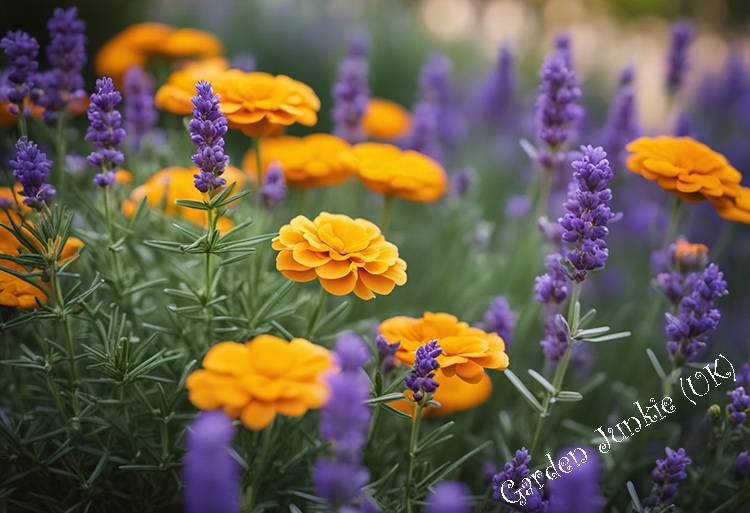
Companion planting UK: Companion planting or ‘polyculture’ is a garden and gardening technique that has been used by gardeners and farmers for centuries in the UK, and many other parts of the world to promote healthy plant growth and increase yields. It involves planting different crops or plants together, which can benefit each other in various ways. For example, some plants can repel pests that are harmful to their companion plants, while others can attract beneficial insects that help with pollination.
Companion planting is based on the idea that certain plants have natural affinities with one another and that by planting them together, they can support each other’s growth and health.
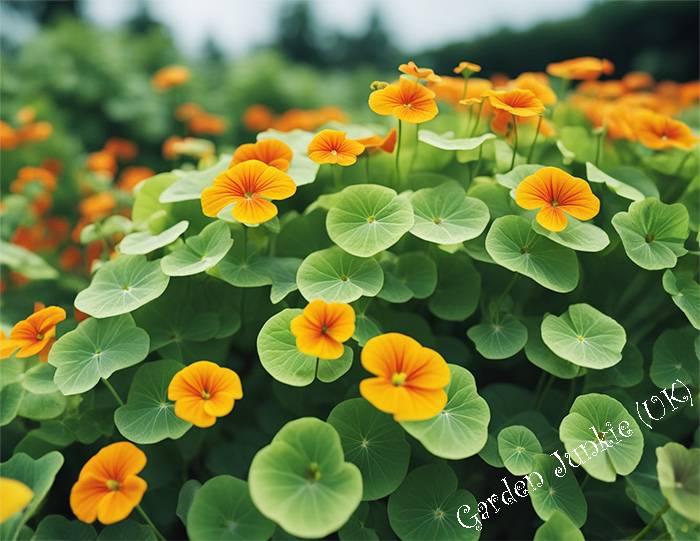
Companion Planting UK: Nasturtiums, One Of The Most Popular Companion Plants In The UK. They Attract Pollinators Like Bees, Butterflies
Companion Planting UK: It’s Become a Popular Planting Method
In the UK, companion planting is becoming increasingly popular among gardeners who want to grow healthy, organic produce. The benefits of companion planting are numerous, including improved soil health, reduced pest damage, and increased crop yields. By planting complementary crops together, you can create a diverse and thriving garden that is more resistant to disease and pests.
If you want to try ‘companion planting’ in your garden, many resources are available to help you get started. This post is full of useful and practical information, as well as online companion planting books, guides, apps and workshops, there are plenty of ways to learn about the best companion planting combinations for your specific needs. Whether you’re a seasoned gardener or just starting, companion planting is a great way to create a healthy and vibrant garden that you can enjoy all season long.
Companion Planting UK: Some Great Ideas, It’s Not As Difficult As You May Think. Check Out The App The Garden Planner.
Principles of Companion Planting
The principles of companion planting are based on the idea that plants have specific needs for light, water, soil, and space. By understanding these needs, you can choose plants that will complement one another and help each other grow.
Here is one example, some plants are what we call ‘nitrogen fixers’, the best of these are Legumes, such as green peas, and green beans and the best ‘nitrogen fixer’ above all is alfalfa. These ‘nitrogen fixers’ can convert ‘atmospheric’ nitrogen into a soluble form usable by plants as fertiliser. This is done through a beneficial relationship with bacteria like ‘rhizobia’.
The plant provides sugars to the bacteria, which in turn converts nitrogen gas from the air into a usable form for the plant. This symbiotic (mutually beneficial) partnership allows legumes to obtain nitrogen from the air instead of the soil. We as gardeners usually add nitrogen to the soil through a fertilizer of some form or another.
Therefore, by planting nitrogen-fixing plants with other plants that need nitrogen, you can improve the soil quality and support the growth of both plants. Of course, you can perhaps save a little on fertiliser too.
Understanding Plant Relationships – Insects
Companion planting in the UK and companion planting generally, is based on the idea that plants have complex relationships with each other and that these relationships can be beneficial or harmful. For example, some plants attract beneficial insects that can help control pests, while others repel pests or attract predators that can eat pests. By understanding these relationships, you can choose companion plants that will help control pests and promote the general health of your crops.
Overall, companion planting can be a valuable tool for any gardener looking to improve the health and yield of their crops/plants. As a ‘vegetable gardener’ for example, choosing the right companion plants and understanding the principles of companion planting, you can create a healthy and productive vegetable garden that will provide you with fresh, nutritious produce all season long.
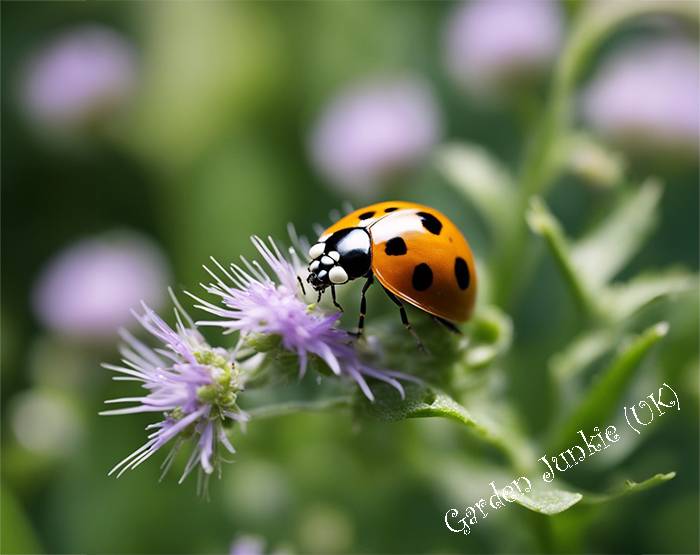
Companion Planting UK: Ladybirds Are Ferocious Predators Of Aphids And Whiteflies. Plant Pollen-Rich Blooms And Flat-Topped Flowers Like Marigolds And Daisies To Attract Them Into The Garden
Companion Planting Strategies
When it comes to companion planting in the UK, there are several strategies you can use to maximise the benefits of this gardening method. The sections below will explore four key strategies: Maximising Space and Light, Soil Health and Nutrient Sharing, Pest Management, and Pollination and Increasing Yield.
Maximising Space and Light
One of the primary benefits of companion planting is that it allows you to maximise the use of space and light in your garden. By planting tall plants such as peas or sweet corn, you can create partially shaded conditions for crops that are prone to ‘bolting’ (a term applied to vegetable crops when they prematurely run to seed, usually making them unusable) This can help to keep your plants healthy and productive throughout the growing season.
Soil Health and Nutrient Sharing
Companion planting can also help to improve the health of your soil and encourage nutrient sharing between plants. For example, vegetables like beans and peas can help to fix the imbalance of nitrogen in the soil, which can benefit other plants that use nitrogen to grow, such as Brussels sprouts and rhubarb.
Pest Management
Another key benefit of companion planting is that it can help manage pests in your garden. By planting certain herbs and flowers alongside your vegetables, you can deter pests such as aphids and ants, while attracting beneficial insects such as hoverflies and bees. For example, ‘nasturtiums’ are known to deter aphids, while ‘garlic’ and ‘marigolds’ can be used as sacrificial plants to deter pests from attacking your other crops.
Pollination and Increasing Yield
Finally, companion planting can also help to increase pollination and yield in your garden. By planting flowers and herbs that attract pollinating insects, you can improve the pollination of your crops and increase your overall yield. For example, planting tomatoes with calendula or runner beans with sweet peas can help to attract bees and other pollinating insects to your garden.
Overall, companion planting is a versatile and effective gardening method that can help to improve the health and productivity of your garden. By using these strategies, you can maximise the benefits of companion planting and create a thriving, sustainable garden.
Popular Companion Planting Combinations
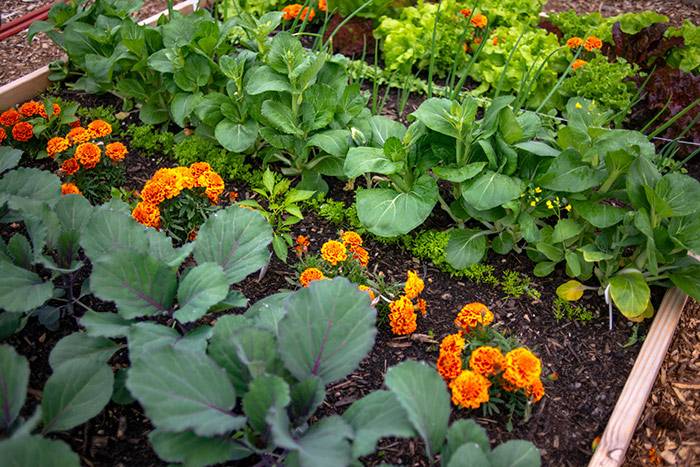
Companion Planting UK: Marigolds are Popular Companion Plants, planted In Combination With Several Other Plants To Combat Pests
If you’re interested in companion planting, you’ll want to know which plants work best together. Here are some popular companion planting combinations for different types of vegetables, with a general companion plant chart for you to check out.
Tomato Companion Plants
Tomatoes are very popular to grow in the UK. You can grow tomatoes in pots, in a greenhouse or the garden, but wherever they are grown they can be susceptible to pests and diseases.
To help protect your tomato plants, try planting them with basil or marigolds. These plants are known to ‘repel pests’ that can damage tomatoes, such as aphids and whiteflies. Onions and ‘garlic’ can also be good companions for tomatoes, as they can help to deter pests and diseases as well.
Brassicas and Their Allies
Cabbage, broccoli, Brussels sprouts, and kale are all part of the brassica family, and they can benefit from certain companion plants. For example, thyme, sage, and rosemary can help to repel pests that can damage brassicas, such as cabbage worms and aphids. Legumes, such as peas and beans, can also be good companions for brassicas, as they can help to ‘fix nitrogen’ in the soil.
Legumes and Their Companions
Peas, beans, and other legumes are known for their ability to fix nitrogen in the soil, which can benefit other plants. For example, planting corn with beans or peas can help to improve the growth of both crops. Squashes can also be a good companion for legumes, as it can help to shade the soil and retain soil moisture.
Root Vegetables and Their Partners
Carrots, onions, leeks, and other root vegetables can benefit from certain companion plants. For example, planting radishes with carrots can help to deter pests that can damage carrot roots, such as carrot flies. Onions and chives can also be good companions for root vegetables, as they can help to deter pests and improve soil health.
By using companion planting, you can help to improve the health and yield of your vegetable garden. Try experimenting with different companion planting combinations to see what works best for your garden.
Companion Planting Chart
| Plant | Companion(s) | Benefit |
|---|---|---|
| Beans (Bush & Runner) | Corn, Nasturtiums, Marigolds | Provides shade for beans, attracts beneficial insects, deters pests |
| Beetroot | Onions, Lettuce, Spinach | Deters leaf miners, improves beetroot flavour |
| Broccoli | Carrots, Dill, Marigolds | Improves broccoli growth, deters cabbage moths |
| Brussels Sprouts | Rosemary, Thyme | Repels whiteflies to improve flavour |
| Calabrese (Green Cauliflower) | Mint, Thyme | Deters cabbage moths |
| Carrots | Leeks, Onions, Tomatoes | Deters carrot flies, leek moths, improves growth |
| Cauliflower | Beans, Peas, Thyme | Fixes nitrogen in soil, deters cabbage moths |
| Celery | Leeks, Cabbage | Deters large and small white butterflies |
| Chervil | Radish, Lettuce, Broccoli | Improves flavour and growth |
| Chives | Carrots, Lettuce, Tomatoes, Nasturtiums | Deters carrot flies, aphids, improves growth and flavour |
| Coriander | Tomatoes | Improves tomato growth, and shade |
| Courgettes | Beans, Nasturtiums, Marigolds | Provides shade for beans, attracts beneficial insects, deters pests |
| Cucumbers | Beans (Bush), Dill, Marigolds | It provides shade for beans, attracts beneficial insects, deters pests |
| Eggplant (Aubergine) | Beans (Bush) | Provides nitrogen for beans |
| Fennel | Peas, Lettuce | Keep pests and diseases away, and avoid depleting the soil of nutrients |
| Garlic | Beetroot, Carrots, Strawberries | Deters aphids, ants, moths and other insects |
| Herbs (most) | Tomatoes, Roses | Improves flavour and deters pests |
| Kale | Herbs (most) | Attract predatory insects that keep pests at bay |
| Leeks | Carrots, Strawberries | Deters carrot flies, improves strawberry growth |
| Lettuce | Beetroot, Carrots, Radishes | Provides shade for lettuce, deters pests |
| Marigolds (French & Pot) | Most Vegetables | Deters a wide range of pests |
| Nasturtiums | Beans, Brassicas, Cucumbers | Attracts beneficial insects, deters aphids |
| Onions | Beetroot, Carrots, Lettuce | Deters carrot flies, improves flavour of other plants |
| Oregano | Beans, Tomatoes | Improves bean and tomato flavour, deters pests |
| Parsley | Tomatoes | Improves tomato flavour |
| Peppers | Basil, Garlic | Improves the growth of both plants, deters aphids |
| Potatoes | Beans (Bush), Nasturtiums | Fixes nitrogen in soil and deters pests |
| Pumpkins | Sunflowers, Marigolds, Nasturtiums, Beans (Pole) | Natural support attracts pollinators and deters pests |
| Radishes | Beans, Lettuce, Peas | Deters broad bean beetles, adds flavour, and provides shade for lettuce |
| Raspberries | Borage | Attracts bees and other pollinators |
| Rosemary | Beans, Cabbage | Improves bean flavour, repels cabbage moths |
| Sage | Carrots, Strawberries | Improves carrot flavour, and deters pests from both strawberries and carrots |
| Spinach | Beans (Bush), Peas, Strawberries | Provides shade for spinach, fixes nitrogen in soil |
| Squash (Summer & Winter) | Beans (Bush), Corn | Deters pests, and improves nutrient uptake |
| Strawberries | Borage, Garlic, Lettuce | Improves strawberry growth, deters pests |
| Swiss Chard | Onions, carrots, lettuce | Deters pests, and improved nutrient uptake |
| Thyme | Beans, Cabbage | It provides shade for beans, attracts beneficial insects |
| Tomatoes | Basil, Marigolds, Nasturtiums | Improves tomato flavour, attracts beneficial insects, deters pests |
| Turnips | Beans (Bush), Peas | Fixes nitrogen in soil and improves growth |
| Watercress | Mint | Helps repel pests like aphids and ants |
Companion Planting UK: General Companion Planting Chart
Companion Planting in Small Spaces
If you have limited space for your garden, don’t worry! Companion planting can still work for you. Here are some techniques you can use to make the most of your small garden.
Container Gardening
Container gardening is a great option for those with small gardens and or limited space. However, you can continue with your companion planting plans and still grow a variety of plants, including herbs, lettuce, and strawberries, in your containers.
When choosing containers though, one of the primary requirements is to make sure they are deep enough for your chosen plant’s roots to grow. You can also choose visually appealing containers that add to your garden’s aesthetics.
Vertical Gardening
Vertical gardening is another great option for smaller UK gardens and adopting companion planting techniques. You can grow climbing plants like climbing beans, runner beans, and tall plants like sunflowers vertically for shade for other plants like pumpkins. This technique saves space and adds visual interest to your garden. You can use trellises, stakes, and other structures to support your plants.
Companion Planting – Intercropping Techniques
Intercropping is the practice of growing two or more crops in the same space. This technique is great for small gardens as it maximises space utilisation. You can grow crops like radish, lettuce, carrots, and onions between taller plants like beans and tomatoes. This technique also helps to reduce soil erosion and improve soil fertility.
In conclusion, companion planting can work in small spaces too. By using alternative techniques like container gardening, vertical gardening, and intercropping, you can make the most of your limited space and grow a variety of crops.
Managing Pests and Attracting Beneficial Insects
Companion planting is also an effective method to manage pests and attract beneficial insects to your garden. As we have mentioned, planting certain plants together can create a natural pest control system that reduces the need for chemical pesticides. Here are some ways to manage pests and attract beneficial insects.
Natural Pest Deterrents
Certain plants have natural compounds that repel pests. Garlic, onions, and chives are known to deter aphids, ants, and other pests. Marigolds are also effective at deterring pests, especially nematodes. Nasturtiums are another plant that can help deter pests, including whiteflies and squash bugs. Planting these natural pest deterrents alongside your vegetables can help protect them from damage.
Attracting Predator Insects
Another way to manage pests is to attract predator insects that prey on garden pests. Hoverflies and ladybirds are two beneficial insects that can help control aphids and other pests.
You can attract hoverflies by planting flowers such as alyssum, calendula, and yarrow. Ladybirds can be attracted by planting plants such as dill, fennel, and coriander. Birds such as blue tits and great tits are also beneficial as they eat caterpillars and other pests. You can attract birds to your garden by providing bird tables, feeders and nesting boxes.
Encouraging Pollinators
Pollinators such as bees and butterflies are essential for the pollination of many plants, including vegetables. By planting flowers such as lavender, thyme, and borage alongside your vegetables, you can attract pollinators to your garden. This will help to increase the yield of your vegetables.
Bees are especially important as they are responsible for pollinating many of our food crops. Providing a source of water, such as a bird bath or shallow dish, can also help attract pollinators to your garden.
By using natural pest deterrents, attracting predator insects, and encouraging pollinators, you can create a healthy and thriving garden. Companion planting is an effective and natural way to manage pests and attract beneficial insects to your garden.
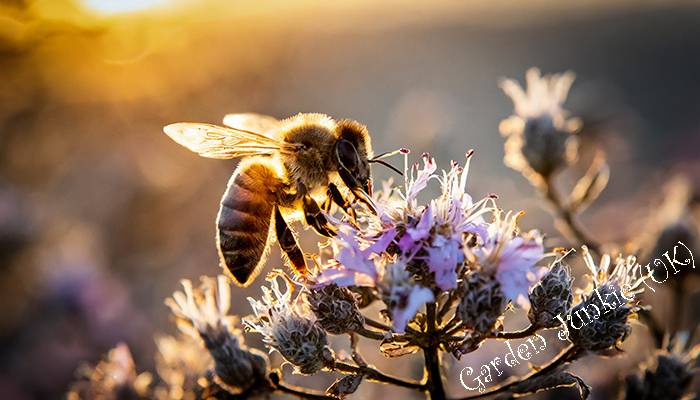
Companion Planting UK: Attract Pollinators Like Bees Into Your Garden by Planting Lavender or Borage
Avoiding Negative Plant Interactions
Companion planting is a great way to improve the health and yield of your vegetable garden. However, it’s essential to know which plants to keep apart to avoid negative interactions. Here are some tips to keep in mind when companion planting.
Which Plants to Keep Apart
Some plants can inhibit the growth of others or attract pests and diseases. For example, potatoes and tomatoes are in the same family and can both attract the Colorado potato beetle. Therefore, it’s best to avoid planting them together. Similarly, cabbages and cucumbers should be kept apart as they can stunt each other’s growth.
It’s also important to avoid planting certain plants near trees with ‘allelopathic’ properties, such as walnut and eucalyptus. These trees release chemicals that can inhibit the growth of nearby plants. Sunflowers are another plant that can release allelopathic chemicals, so it’s best to keep them away from many but not all plants.
Understanding Allelopathy
Allelopathy is the phenomenon where one plant releases chemicals that inhibit the growth of another plant. It’s important to understand allelopathy when companion planting to avoid negative interactions.
For example, when planting beans, it’s best to avoid planting them near plants that release allelopathic chemicals, such as fennel and sunflowers. On the other hand, beans can release allelopathic chemicals that can inhibit the growth of plants in the onion family, so it’s best to keep them apart.
In summary, avoiding negative plant interactions is essential for successful companion planting. Keep in mind which plants to keep apart and understand allelopathy to ensure the health and yield of your vegetable garden.
Seasonal Companion Planting
When it comes to companion planting, it’s important to consider the seasons. Different plants thrive in different conditions, and planting the right combinations can help to maximise growth and harvest. Here’s a guide to seasonal companion planting in the UK.
Spring Planting Guide
Spring is the time to start planting cool-season crops such as lettuce, radishes, and peas. These plants can be grown together in the same bed, as they don’t compete for nutrients. Onions are also a good companion for these plants, as they can help to repel pests such as aphids.
Tomatoes and peppers can be started indoors in the spring, ready for planting out in the summer. They should be planted separately from cool-season crops, as they prefer warmer temperatures. Cucumbers and squash can also be planted in the spring but should be given plenty of space to grow.
Summer Planting Guide
Summer is the time to plant warm-season crops such as tomatoes, peppers, cucumbers, and squash. These plants can be grown together in the same bed, as they have similar growing requirements. They also benefit from the shade provided by taller plants such as corn.
Garlic and onions can also be planted in the summer, as they prefer warm soil. They are good companions for tomatoes, as they can help to repel pests such as whitefly.
Autumn Planting Guide
Autumn is the time to plant cool-season crops such as lettuce, radishes, and peas again. These plants can be grown together in the same bed, as they prefer cooler temperatures. Broad beans and asparagus can also be planted in the autumn, as they prefer cooler weather.
When planning your autumn garden, it’s important to consider crop rotation. Avoid planting the same crops in the same bed year after year, as this can lead to a build-up of pests and diseases. Instead, rotate your crops to different beds each year.
By following these seasonal companion planting tips, you can help to maximise growth and harvest in your garden.
Companion Planting for Specific Pests
If you’re growing vegetables in your garden, you’re likely to encounter some pests that can damage your plants. Fortunately, there are companion plants that can help you control these pests without resorting to chemical pesticides. Here are some common pests and companion plants that can help you manage them.
Managing Aphids and Whitefly
Aphids and whitefly are common pests that can suck the sap from your plants and spread disease. To control them, you can plant marigolds, nasturtiums, garlic, and chives. These plants have strong scents that can confuse the pests and keep them away from your vegetables. You can also use reflective mulches or sticky traps to repel these pests.
Controlling Slugs and Snails
Slugs and snails are notorious in the UK and most other places in the world for ‘eating’ holes in leaves and leaving ‘slime trails’ ‘behind. To control them, you can use beer traps or copper tape around your plants. You can find out more about how to combat ‘slugs’ in our post ‘How to stop slugs eating plants‘.
In addition, you can also plant rosemary, onions, and leeks as companion plants in the UK, which is a popular way to manage these pests. These plants have strong scents that can repel slugs and snails.
Deterring Carrot Root Fly
Carrot root fly is a pest that can damage the roots of your carrots. To control them, you can plant onions, leeks, or chives as companion plants. These plants have strong scents that can confuse pests and keep them away from your carrots. You can also cover your carrot bed with a ‘fine mesh’ to prevent the adult flies from laying eggs on your plants.
Which Vegetables Should Be Planted Together For Optimal Growth?
Certain vegetables grow better when planted together, while others should be kept apart.
For example, tomatoes and basil are ideal companions, as basil repels pests that commonly affect tomatoes. Similarly, carrots and onions are a good match, as onions repel carrot flies.
However, it is important to avoid planting members of the same family together, such as tomatoes and peppers, as this can lead to the spread of diseases.
What Are The Ideal Companion Plants For Parsnips In The UK?
Parsnips grow well alongside various plants, including beans, peas, and garlic. Additionally, planting parsnips alongside herbs such as sage and thyme can help to repel pests and improve their flavour.
How Does Companion Planting With Garlic Benefit a UK Garden?
Garlic is a natural pest repellent and can help to keep pests such as aphids and slugs away from your garden. Additionally, planting garlic alongside other plants can help to improve their flavour and protect them from disease.
What Should Not Be Planted Next To Spinach In a Companion Planting Scheme?
Spinach should not be planted next to members of the brassica family, such as broccoli and cauliflower, as they can attract pests that commonly affect spinach. It is also important to avoid planting spinach near strawberries, as they can compete for nutrients and water.
Which Flowers Can Be Grown Alongside Vegetables to Enhance a UK Garden?
Flowers such as marigolds, nasturtiums, and calendula can be grown alongside vegetables to help repel pests and add colour and beauty to your garden. Additionally, planting flowers such as borage and chamomile can help to attract beneficial insects such as bees and butterflies.
What Are The Advantages of Using a Companion Planting Chart for UK Vegetable Gardens?
A companion planting chart can help you plan your garden more effectively and ensure that your plants are growing in the best possible conditions. By following a chart, you can avoid planting incompatible plants together and ensure that your garden is healthy and thriving.
Conclusion
Remember that companion planting is not a magic bullet, and it may not work for all pests. However, it is a natural and effective way to control pests without harming the environment.
Companion planting can be a beneficial and sustainable practice for gardeners. By strategically pairing compatible plants, gardeners can help control pests, improve soil health, and maximise the productivity of your garden. Additionally, companion planting can contribute to a diverse and visually appealing garden landscape. Gardeners need to research and understand the specific needs and interactions of different plant species to make the most of companion planting in the UK.
